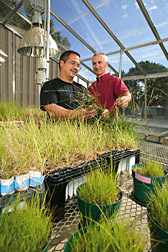This page has been archived and is being provided for reference purposes only. The page is no longer being updated, and therefore, links on the page may be invalid.
Read the magazine story to find out more. |
|
Learning More About Beneficial Soil Fungi
By Jim CoreJanuary 19, 2006
Beneficial soil fungi that help plants grow could become easier for farmers to use, based on research by Agricultural Research Service (ARS) scientists who are studying these valuable organisms.
The fungi, called mycorrhizal fungi, live inside and outside root cells and help them reach for nutrients by extending long threads called hyphae into the soil. The plant, in exchange, provides the fungi glucose and possibly other organic materials that they need to survive. Unfortunately, modern agricultural practices have reduced populations of arbuscular mycorrhizal (AM) fungi, the most common type.
By learning more about AM fungi physiology and finding ways to grow colonies without host plants, ARS scientists at the Eastern Regional Research Center in Wyndmoor, Pa., hope to make the fungi a practical option for producers.
Currently, researchers cannot cultivate an AM fungus without a host because the fungus can't complete its life cycle without the organic nutrients or other stimuli it receives from roots. Gerald Nagahashi, a chemist/cell biologist at ERRC, has been focusing on the events that must occur before the fungus can colonize a host plant.
He developed a bioassay showing that host root components--including chemical compounds exuding from the roots, root caps and root border cells--induce fungal hyphal branching. The increase in branching creates a greater potential for the fungus to find and attach to the host root surface.
Nagahashi and David D. Douds, an ERRC microbiologist, investigated how environmental factors, such as chemical compounds from host roots, blue light from the sun’s spectrum, and carbon dioxide, affect AM fungal growth, either individually or together.
Their techniques involved growing host roots in sterile culture and using sterile fungal spores to study various environmental factors individually or in combination. They found that these three factors--root chemicals, blue light and carbon dioxide--can all work independently to promote growth in AM fungi but are even more effective when applied together.
Read more about this research in the January 2006 issue of Agricultural Research magazine.
ARS is the U.S. Department of Agriculture's chief scientific research agency.

